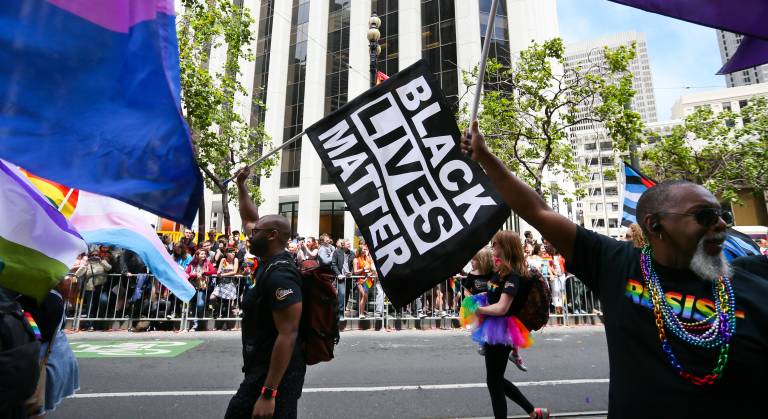By Rev. Irene Monroe, published in WGBH News on June 11, 2020

June is Pride Month for LGBTQ+ communities across the country — and this year, Boston’s turns 50. And while COVID-19 and social distancing guidelines have forced Pride to go virtual this year, a half-century of struggle and triumph will not go uncelebrated.
This Pride milestone coincides with the eruption of protests across America because, once again, an unarmed black man was killed at the hands of police brutality. George Floyd’s death symbolizes the new face of anti-black violence, as Matthew Shepard’s face came to symbolize homophobic violence after his murder in 1998. LGBTQ+ civil rights and black civil rights histories intersect on many issues — with violence and police brutality among them.
I hope the riots and protests occurring now, as a result of Floyd’s death and the police killing of 26-year-old Breonna Taylor in Louisville, Ky., will sustain the Black Lives Matter movement.
With 50 years in the making, Boston Pride has played an integral part in highlighting our political movement of self-acceptance. Boston Pride, which would have held its flagship Parade this Saturday, binds us all to a common struggle for LGBTQ equality. Moving forward in the aftermath of Floyd’s death, I hope the entire LGBTQ+ community better embraces intersectional concerns and goals to best address systemic racism and police violence, which both my communities — African American and LGBTQ+ communities — share.
Floyd’s death appears to be an inflection point and wake-up call for white America. For the first time ever, this Pride month, LGBTQ+ communities and organizations across the country are elevating the voices and faces of its black communities. For some LGBTQ+ people of African descent, however, the gesture is at best too late, and at worst, a clear sign of tokenism — seizing the moment to be politically correct. Pride events have always mirrored the fissures in society with segments of its community — women, transgender people and people of color — holding their events.
Boston Pride has an inauspicious beginning, comprising of a small motley group of gay and lesbian activists who marched to a Vietnam protest from Cambridge Common to Boston Common in June 1970. The group held a rally on Boston Common, commemorating the Stonewall Riots in New York City’s Greenwich Village the year prior, which began the modern-day LGBTQ+ civil rights movement.
Boston Pride’s profound impact on LGBTQ politics, both here in the Bay State and across the country, couldn’t have been predicted. Massachusetts is known as an LGBTQ-friendly state, and we have the court victories to prove it. With civil rights gains such as transgender protections, the legalization of same-sex marriage, a hate crime bill, banning discrimination based on gender identity and sexual orientation in housing, public accommodations, employment, and the banning of conversion therapy, to name a few, we had come a long way since the first Pride march five decades ago.

Yet with these advances come disadvantages. For some in the LGBTQ+ community, Boston Pride has become too corporate. Many see the company floats and paraphernalia as selling the soul of the movement’s grassroots message for entry into the mainstream. However, others in the community welcome corporate sponsors, viewing it as vital for the financial cost and continuation of Boston Pride and affirming of LGBT+ issues and their employees.
But as Boston Pride becomes more corporate, marginal groups within the LGBT+ movement have become more invisible. After decades of Pride events, where many LGBTQ+ of African descent have tried to be included and were rejected, Black Pride was born. Boston Black Pride, for example, focuses on its community needs, such as HIV/AIDS, unemployment, housing, police brutality, and now COVID-19. Sunday gospel brunches, Saturday night poetry slams, Friday evening fashion shows, bid whist tournaments, house parties, the smell of soul food and Caribbean cuisine, and the beautiful display of African art and clothing are just a few of the cultural markers that make Black Pride distinct from the dominant queer culture.
The continued distance between the white LGBTQ+ community and LGBTQ+ communities of color has a historical antecedent. Many LGBTQ people of African descent and Latinos argue that the gulf between them and white people is also about how the dominant queer community rewrote and continues to control the history of Stonewall.
The Stonewall Riots of June 27-29, 1969, started on the backs of working-class African-American and Latino queers who patronized that New York City bar. Those brown and black LGBTQ people are not only absent from the photos of that night, but they are also bleached from its written history. Because of the bleaching of the Stonewall Riots, the beginning of the LGBTQ+ movement post-Stonewall is an appropriation of a black, brown, trans, and queer liberation narrative. It is the deliberate visible absence of these African-American, Latino, and API LGBTQ+ people that makes it harder, if not nearly impossible, for LGBTQ+ communities to build trusted coalitions with white LGBTQ+ communities.
For example, in 2017, Philadelphia had a controversy over its new Pride flag. Black and brown stripes were added to the rainbow flag as part of the city’s “More Color More Pride” campaign as a way to visibly include people of color in the celebrations.
“It’s a push for people to start listening to people of color in our community, start hearing what they’re saying, and really to believe them and to step up and say, ‘What can I do to help eradicate these issues in our community?'” said Amber Hikes, the executive director of Philadelphia’s Office of LGBT Affairs told NBC Out at the time.
Boston Pride, presently, includes two programs aimed at LGBTQ people of color — Black Pride and LatinX Pride. But more must be done.



